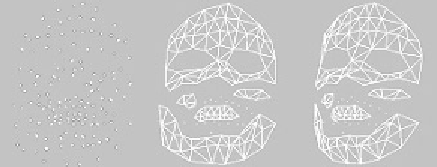Game Development Reference
In-Depth Information
Figure 2. (a) The generic model in iFACE; (b) A personalized face model
based on the cyberware scanner data; (c) The feature points defined on
generic model for MU adaptation.
(a)
(b)
(c)
“iFACE,” a face modeling and animation system developed in Hong, Wen &
Huang (2001). iFACE is illustrated in Figure 2.
The Motion Capture Database
We use motion capture data from Guenter et al. (1998). The database records
the 3D facial movements of talking subjects, as well as synchronous audio
tracks. The facial motion is captured at the 3D positions of the markers on the
faces of subjects. The motion capture data used 153 markers. Figure 3 shows
an example of the markers. For the purpose of better visualization, we build a
mesh based on those markers, illustrated by Figure 3 (b) and (c).
Figure 3. The markers. (a) The markers shown as small white dots; (b) and
(c) The mesh is shown in two different viewpoints.
(c)
(a)
(b)






Search WWH ::

Custom Search